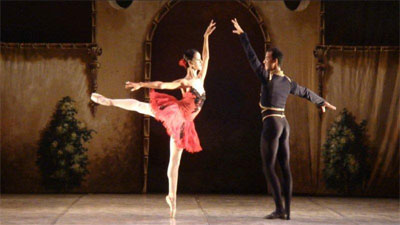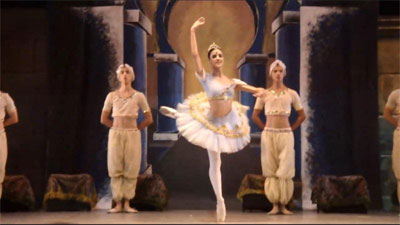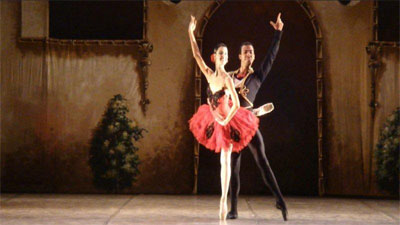Cuban Ballerina Patricia Hernandez
Prima ballerina of the Ballet Laura Alonso
Helson Hernandez

HAVANA TIMES — “The reality of a dancer is as complex as that any other person’s. I know that people imagine dancers to be like those porcelain dolls that break if you squeeze them a little, or maybe like women who are somewhat stretched,” said Patricia Hernandez in her interview with HT.
HT: Are there other artists in your family?
Patricia Hernandez: There are only two other artists in my family: my aunt Rebeca Chavez, now a filmmaker, and my uncle Senel Paz, who’s a screenwriter, journalist and writer. Outside of them, everybody else is engaged in various occupations that have no relationship to art.
HT: Tell us about Patricia’s link with the world of ballet.
PH: I started in the world of ballet when I was very young because my parents realized it was the only way to keep me quiet. They would take me to activities involving musical education and dance companies, and later my teachers would take me from one place to another so I could sing or dance.
There was something odd about music that made me move to it. It was unavoidable. It seemed like I was hypnotized. They decided to test me for ballet, which led to my taking classes when I was only three. Years later I realized this was what I wanted to do for the rest of my life.
HT: Going back to your training, what thoughts would characterize your personal experience during that stage?
PH: The first thing that goes through my mind is the sacrifice, work and the restrictions I encountered at that stage of childhood and adolescence. It takes eight years for one to be fully trained, but during that time there isn’t only satisfaction; rather, I’d say it’s a road full of obstacles that are erected with every step you take, which often bring suffering, limitations and dissatisfaction.
It’s a very difficult path where what counts most is reaching the goal. This means never giving up, though sometimes things happen that make you think the earth’s crumbling under your feet.

For women, I dare say that the demands are a bit greater, especially since we have to take care of our figures and never neglect them. That’s something pretty complicated for a girl or young woman since you have to forget all those foods that everyone enjoys, at least during that developmental stage. Such pleasures have a terrible impact on the aesthetics of a dancer.
In addition, more women are involved in this art form, so the competition is greater. This means I had to work twice as hard to reach the top and not be left out once school was over.
In short, there are many things needed in order to remain in this consecrated profession, where what’s truly essential is that you love it.
HT: What happened after you graduated from the Cuban School of Ballet?
PH: When you have your diploma in hand, or better yet, when you manage to graduate with honors from the National School of Ballet, you feel a joy so immense that it’s hard to describe. You feel rewarded for all the effort and you’re thrilled about being closer to your goal. But there’s also tremendous nostalgia for the teachers and friends you’ll have to leave behind, those who constantly fought by your side.
I think that being able to go to that institution is a huge privilege for every dancer. It’s one of the most prestigious schools and it enjoys worldwide recognition. It’s a place where you can increase your knowledge, strengthen your base and prepare yourself for professional life ahead.
HT: What has the Centro Pro-danza de Cuba contributed to the career of Patricia Hernandez?
PH: Centro Pro-Danza, and Ballet Laura Alonso specifically, have made me what I am today. A person leaves school with a high artistic and technical level, but what really makes the dancer is what happens on stage, and that opportunity was given to me by Pro-danza. I’m referring to Laura Alonso and members of the company who gave me the privilege of playing leading roles in classics like Paquita, The Nutcracker, La Bayadere, Swan Lake, Don Quixote, La Sylphide y el Escoces, La Fille Mal Gardee and Romeo and Juliet after I started when I was just 19.

Today I’m 23 and I feel privileged for having all these pieces in my repertoire, despite being so young. So, the greatest contribution of Pro-Danza to my career has been my development as an artist, the experience I gained, and my becoming a prima ballerina.
HT: How could you summarize the reality faced by an exponent of classical ballet in everyday Cuban life?
PH: The reality of a dancer is as complex as that of any other person’s. I know that people imagine dancers to be like those porcelain dolls that break if you push them a little, or maybe like women who are somewhat stretched. All this is understandable since in our profession we have a typical way of walking and certain characteristics that distinguish us from other people.
But those are only appearances. We’re ordinary people with the same needs and problems of any other Cuban. We have to run to catch the bus to get to our trials early. We have to get in lines like everybody else. We like to have fun like any other youths and in our spare time we go to parties, listen to music and read. We’re just like any other Cubans in this society.
HT: Tell us about your experience of dancing in France.
PH: That was one of the most rewarding experiences in my life. Firstly, because it was there that ballet reached its peak and its highest level of development. They have one of the most recognized companies in the world, the Paris Opera, and people have a rather high level of dance culture. As we used to say in good Cuban back then, “Fuimos a bailar a casa del trompo” (We went to dance on the expert’s stage).
Secondly, we were able to see several cities in that beautiful country, its most relevant sites, learn about the customs of the general population and that nation’s amazing history. It was a trip where we worked really hard. What was curious is that we did this all in atypical locations.
We didn’t dance in common scenarios; instead, we performed at vacation spots, outdoor amphitheaters and recreation sites for the general public. These were for people who weren’t used to seeing these types of performances since they ordinarily couldn’t afford them.

For me it was a truly pleasure to give and share our art with them and to meet with the public after the shows. The audiences gave us very warm welcomes, full of praise, applause and thanks for what we presented – night after night. That’s why, despite the fatigue we felt upon returning to Cuba, it was a tour that I’ll guard in in my memory forever.
HT: What remains to be accomplished to complete your personal realization?
PH: I’d say it’s almost impossible for me to separate the personal from the professional. I think these two paths in my life are too closely intertwined. So for me to feel complete, I need to accomplish several goals that still remain. Among them are dancing many works from the classical repertoire that I haven’t yet had the privileged to do.
First among those is no other than Giselle. That’s the dream of my life. It’s what I’ve longed for and yearned the most, since I’ve only had the chance to perform the Pas de deux in the second act. I think it’s a work that contributes to the dancer and requires the same histrionics and the highest technical level. To achieve it would be to advance several steps up that huge staircase that represents our careers.
Another thing I want to do is dance more often in international settings. This elevates the dancer since one has to confront audiences with disparate demands. This gives the artist a very vast and varied experience.
There must be many other things I still need to do to feel completely realized, but I feel like I’m on the right track. Although I’ve never felt fully satisfied with my performances, since there are always things that can be improved, it pleases me when the audience appreciates my art and lavishes me with applause and cheers.
HT: What words define Patricia Hernandez as a dancer?
PH: I think the words to define me are perseverance, demanding, and one could even say obsessed with getting increasingly closer to perfection in my dancing. But the word that really gives me the strength to start every new day, despite fatigue or problems, is the passion and immense love I have for what I do. I’m sure this is stronger than any obstacle that may appear. It’s what makes you say, without thinking twice, “If I were born again, I’d be a dancer again.”





